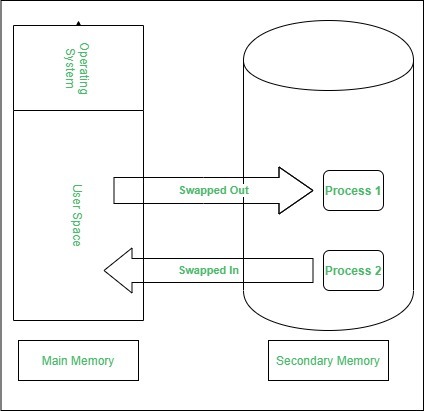Swapping in Operating System (original) (raw)
Last Updated : 14 Jan, 2025
To increase CPU utilization in multiprogramming, a memory management scheme known as swapping can be used. Swapping is the process of bringing a process into memory and then temporarily copying it to the disc after it has run for a while. The purpose of swapping in an operating system is to access data on a hard disc and move it to RAM so that application programs can use it.
What is Swapping in the Operating System?
Swapping in an operating system is a process that moves data or programs between the computer's main memory (RAM) and a secondary storage (usually a hard disk or SSD). This helps manage the limited space in RAM and allows the system to run more programs than it could otherwise handle simultaneously.
It's important to remember that swapping is only used when data isn't available in RAM. Although the swapping process degrades system performance, it allows larger and multiple processes to run concurrently. Because of this, swapping is also known as memory compaction.
The CPU scheduler determines which processes are swapped in and which are swapped out. Consider a multiprogramming environment that employs a priority-based scheduling algorithm. When a high-priority process enters the input queue, a low-priority process is swapped out so the high-priority process can be loaded and executed. When this process terminates, the low-priority process is swapped back into memory to continue its execution. The below figure shows the swapping process in the operating system:

Swapping has been subdivided into two concepts: swap-in and swap-out.
- Swap-out is a technique for moving a process from RAM to the hard disc.
- Swap-in is a method of transferring a program from a hard disc to main memory, or RAM.
**Process of Swapping
- When the RAM is full and a new program needs to run, the operating system selects a program or data that is currently in RAM but not actively being used.
- The selected data is moved to secondary storage, freeing up space in RAM for the new program
- When the swapped-out program is needed again, it can be swapped back into RAM, replacing another inactive program or data if necessary.
Real Life Example of Swapping
Imagine you have a disk (RAM) that is too small to hold all your books and papers (programs). You keep the most important items on the desk and store the rest in a cabinet (secondary storage). When you need something from the cabinet, you swap it with something on your desk. This way, you can work with more items than your desk alone could hold.
Advantages
- Swapping minimizes the waiting time for processes to be executed by using the swap space as an extension of RAM, allowing the CPU to keep working efficiently without long delays due to memory limitations.
- Swapping allows the operating system to free up space in the main memory (RAM) by moving inactive or less critical data to secondary storage (like a hard drive or SSD). This ensures that the available RAM is used for the most active processes and applications, which need it the most for optimal performance.
- Using only single main memory, multiple process can be run by CPU using swap partition.
- It allows larger programs or applications to run on systems with limited physical memory by swapping less critical data to secondary storage and loading the necessary parts into RAM.
- By swapping out inactive processes, the operating system can prevent the system from becoming overloaded, ensuring that the most important and active processes have access to enough memory for smooth execution.
Disadvantages
- Risk of data loss during swapping arises because of the dependency on secondary storage for temporary data retention. If the system loses power before this data is safely written back into RAM or saved properly, it can result in the loss of important data, files, or system states.
- The **number of **page faults increases as the system frequently swaps pages in and out of memory, which directly impacts performance because fetching data from the disk (or swap space) is much slower than accessing it from RAM.
- If the system Swaps-in and out too often, the performance of system can severely decline as CPU will spend more time swapping then executing processes.
Only one process occupies the user program area of memory in a single tasking operating system and remains in memory until the process is completed.
When all of the active processes in a multitasking operating system cannot coordinate in main memory, a process is swapped out of main memory so that other processes can enter it.
For more information, you can refer Difference between Paging and Swapping in OS, and the Difference between Swapping and Context Switching.
Conclusion
Swapping in an operating system is a technique that moves data between RAM and secondary storage to manage limited memory efficiently. It allows the system to run more programs simultaneously by temporarily moving inactive data out of RAM. This process helps improve system performance and ensures that the available memory is used effectively.